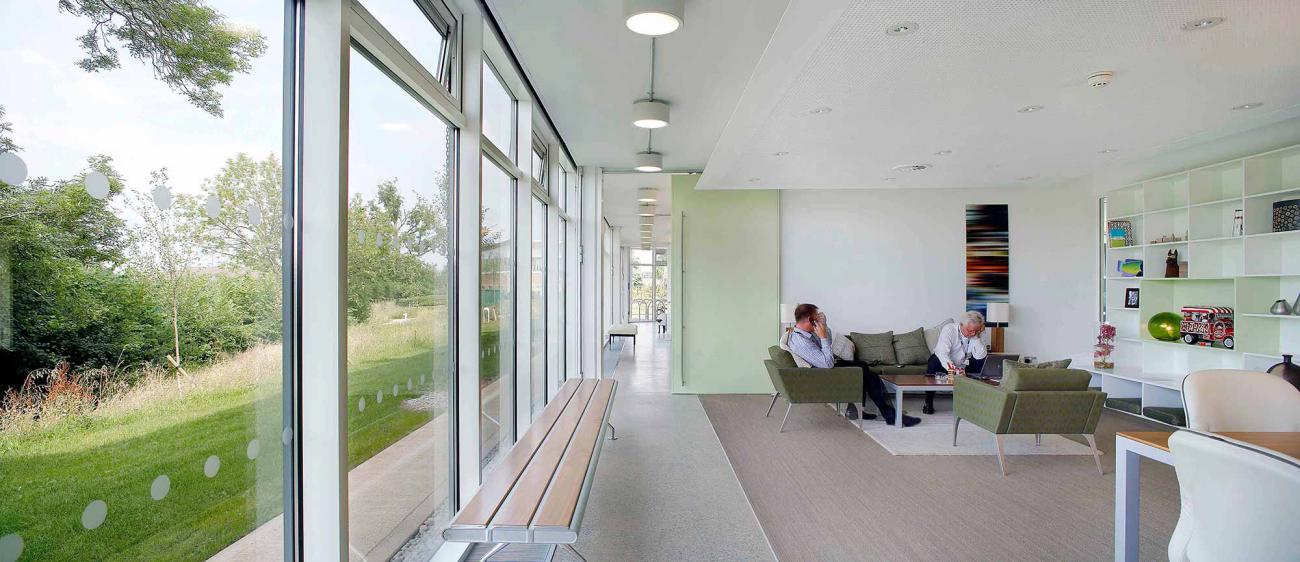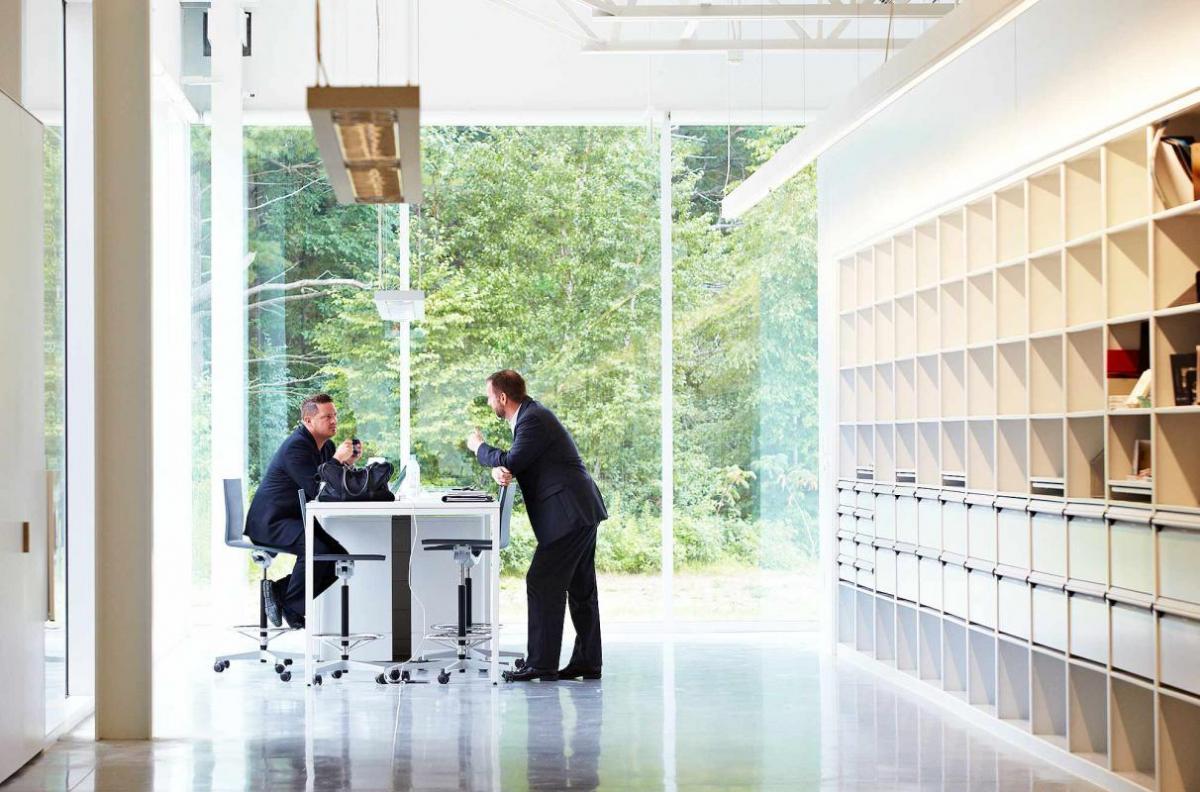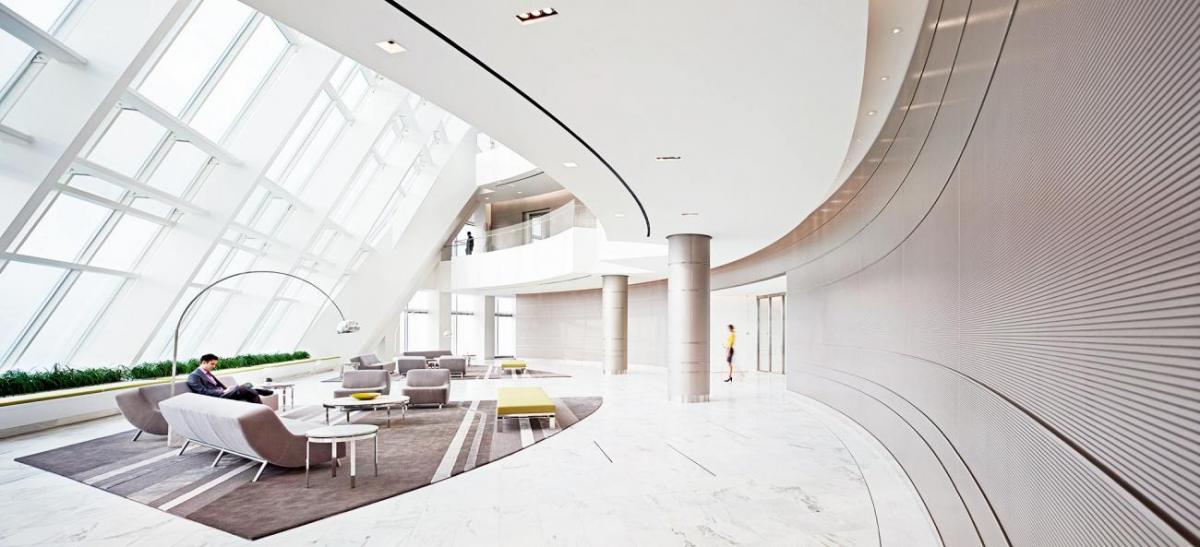
In case you haven’t noticed, health and wellness has quietly become a consequential issue within the business community. Businesses and organizations are preoccupied with making sure their employees are as healthy and happy as can be, and they are willing to invest significant amounts of money to achieve these ends.
The reason behind this new mindset? Numerous studies and mountains of evidence confirm what common sense has long suggested: healthy, happier workers are more productive, more likely to collaborate with colleagues, and more likely to innovate in ways that benefit the bottom line.
So how can a company ensure its workforce is as healthy and happy as possible?
Consider the built environment. Poorly designed workspaces increase the risk of asthma, diabetes, a poor body mass index (BMI), and overall fatigue, while thoughtfully designed workplaces allow workers to leave the office feeling better than when they arrived.
Here are 10 simple, yet impactful design interventions that can pay significant dividends for individuals and your company as a whole.
1. Make Workers More Active
 Sitting is the new smoking. According to the British Journal of Sports Medicine, staying seated for more than one hour causes fat burning enzymes to decline by 90 percent. Long periods of sitting cultivate physical and mental lethargy. Getting employees out of their chairs and onto their feet may seem like a simple and inconsequential step, but it actually pays significant dividends.
Sitting is the new smoking. According to the British Journal of Sports Medicine, staying seated for more than one hour causes fat burning enzymes to decline by 90 percent. Long periods of sitting cultivate physical and mental lethargy. Getting employees out of their chairs and onto their feet may seem like a simple and inconsequential step, but it actually pays significant dividends.
Untether employees from their desk chairs. Create spaces where stand-up meetings can take place. Incorporate indoor walking paths leading to social fitness areas with ping pong tables and other equipment. And allow for the inclusion of stand-up workstations, should your employees choose to get vertical and do their work while standing.
2. Provide Easy Access to Water and Healthy Snacks
Feeling tired? Sluggish? You’re not alone. Workers often lose energy at some point during the day. And when a case of exhaustion strikes, most workers turn to a cup of coffee or soda to try and perk back up.
Unfortunately these remedies are not what the doctor ordered. A Gensler NextGen Study indicates lack of water is the greatest source of fatigue for workers. We are a dehydrated faction, and a lack of our body’s most essential component is what leads to feelings of lethargy.
Combat worker weariness by ensuring easy access to fresh, filtered water. And keep vending machines stocked with natural, healthy foods which leave people feeling alert and energetic rather than sluggish.
3. The Air We Breathe
Absenteeism (aka workers consistently staying away from the office due to illness) is one of the biggest expenditures draining company coffers. Chronic absenteeism cuts into productivity and lowers the bottom line, leaving executives wringing their hands and forcing colleagues to pick-up the slack.
What many businesses don’t realize is that air filled with volatile organic compounds (VOCs) is one of the leading causes of recurring absenteeism. Those same businesses also don’t realize that pursuing LEED design strategies is a simple and effective solution for drastically reducing the presence of VOCs. LEED design requires buildings to feature materials with low VOC emission profiles. A 2009 Michigan State study found that LEED buildings, which also tend filter and circulate air more effectively, reduced absenteeism by 50 percent. According to the study, workers in LEED buildings were less likely to be affected by asthma and other respiratory illnesses and reported less instances of depression and stress.
High CO2 levels are another insidious cause of worker fatigue. Enclosed workspaces such as conference rooms often lack proper ventilation and can expose workers to higher than normal levels of carbon dioxide. This leads to drowsiness and general lethargy. Make sure every room in your workspace is properly ventilated and filtered to keep VOC and CO2 levels to a minimum. Allow the natural air into the workspace whenever possible. And remember: LEED design is an effective way to improve indoor air quality.
4. Nature, Nature Everywhere
 Humans crave the outdoors. And while not everyone can trek the Amazon, filling workspaces with plants and other natural components relaxes employees and fosters productivity. According to research conducted by researchers Waliczek Lohr and Zaijeckn Lineberger, employees who worked in environments containing plants experienced lower levels of stress and demonstrated higher productivity.
Humans crave the outdoors. And while not everyone can trek the Amazon, filling workspaces with plants and other natural components relaxes employees and fosters productivity. According to research conducted by researchers Waliczek Lohr and Zaijeckn Lineberger, employees who worked in environments containing plants experienced lower levels of stress and demonstrated higher productivity.
So while it’s impossible to give every worker a view of a magnificent park, there’s no excuse for not bringing nature into the office.
5. Consider the Sensory Environment
Remember the 90s? The not-so-distant decade when it seemed like every office was a maze of gray-partitioned cubicles and harsh fluorescent lighting? That dullard era of office design was brilliantly mocked in films like Office Space and cartoons like Doonsbury, and thankfully we have moved beyond what, in retrospect, may have been the nadir of workplace aesthetics.
Humans are sensory beings; we respond to visual and auditory cues. Equipping a workspace with appropriate levels of light, soothing textures and colors, and the proper level of background noise helps keep workers alert. We know a lack of visual stimulation dulls people’s senses and contributes to the loss of focus. Considering the sensory elements within an office is critical to preventing such problems.
Here’s one tip: Avoid long expanses of neutral colored corridors or workspaces. Vary the color scheme to avoid predictability and keep things fresh.
6. Acoustics
Acoustics play a critical role in a well-designed workplace. No one wants to work in an office where the HVAC system sounds like a dying car transmission, or sit in a hallway where every tap on the keyboard or sound of a coworker on a conference call is amplified to an unpleasant level. It’s long been assumed that a high level of background noise, such as that found at most coffee houses, provides the optimal environment for focus. But what researchers Robert Karasek and LowellTöres Theorell have discovered is constant, low frequency background noise disrupts learning, engenders fatigue, and increases stress hormones.
Good workplace acoustics mitigate distractions by introducing elements of privacy. A high functioning acoustic workplace keeps background noise, from the hum of appliances to the sound of doors sitting, to a minimum. Achieving appropriate noise levels is a tricky balance of art and science but success in this area is paramount to shielding workers from stress causing distractions.
7. Lighting
 The natural 24-hour cycle of light and dark does more than just let us know when it’s time to get up for work and when it’s time to watch Mad Men. A report from the University of Connecticut Health center found it maintains the alignment of our circadian rhythms and the basic processes our bodies need to function. And if an office disrupts this cycle by providing uniform lighting levels throughout all workspaces, workers will begin to feel discombobulated.
The natural 24-hour cycle of light and dark does more than just let us know when it’s time to get up for work and when it’s time to watch Mad Men. A report from the University of Connecticut Health center found it maintains the alignment of our circadian rhythms and the basic processes our bodies need to function. And if an office disrupts this cycle by providing uniform lighting levels throughout all workspaces, workers will begin to feel discombobulated.
To prevent this, workspaces should provide access to natural daylight. Vary light levels with expansive windows and augment the use of daylight with automated controls and a variety of lighting levels and colors. The full spectrum of lighting is needed to keep people from feeling out of whack, and when an office absolutely can’t use natural light to achieve this, well designed light sources can work as a substitute.
8. Ergonomics 101
As I already mentioned, sitting poses serious health risks to all people. And breaking up the sedentary work style requires more than just stand-up desks and walking plans. Sometimes an office must consider the ergonomics of its furniture to improve posture and make workers more comfortable. A worker with a stiff back caused from an uncomfortable chair is not that likely to get-up and move around.
According to the Occupational Safety and Health Administration, 86 percent of workers experience some discomfort from office furniture, an egregious statistic if there ever was one. Providing comfortable furniture to help mitigate joint stiffness and incorporating flexible workstations which allow workers to change postures during the day can alleviate the problem. Even a well placed staircase will encourage workers to move around more than they normally would.
Remember: Good posture prevents injury and preventing injury keeps workers healthy and engaged.
9. Control Your Destiny
In many respects, the 21st century is the era of customization. We customize our entertainment options through DVRs and on-demand services; we curate our personal brands through social media. So it’s no surprise that we’ve come to expect a certain level of customization from our workspaces. And we tend to get more than a bit peeved when that doesn’t happen.
Don’t let your workers experience, and get distracted by, the consternation that goes hand in hand with a lack of customization options. Personal control over one’s work environment is an intrinsic desire, and there’s no excuse not to give it to employees.
Personal control of storage, lighting levels and HVAC functionality vests each worker with a sense of ownership and gives them the ability to achieve their own level of optimal comfort. Making sure a workspace has a variety of settings, from desks to private focus rooms to larger meeting rooms, also lets people choose when and where to get things done.
10. Everyone Needs a Nudge
Putting healthy design elements into an office is step one. Humans are creatures of habit, meaning it takes some encouragement to break persisting habits and change behavior. Everyone can use a push in the right direction. And another staff email just isn’t going to cut it.
Communicate the location and benefits of healthy design elements through environmental branding and appropriate signage. You don’t have to cover the walls in neon lettering; just provide the appropriate level of information and nudge your employees to leverage all the facets of a redeveloped workspace.
According to a Gensler Next Gen study, it can take up to 21 days to change a workplace behavior. The right mix of graphics and gentle reminders can smooth the transition. ![]()
This article was originally written by Kirsten Ritchie for GenslerOn and reposted in its entirety from www.gensleron.com. To view the original article, click here.

